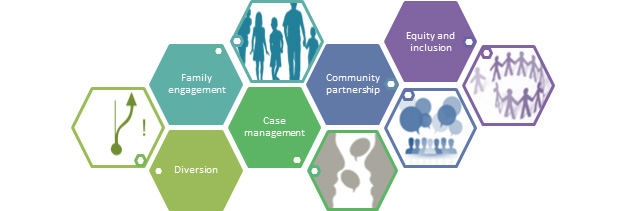Despite it being the most commonly used disposition in juvenile court, community supervision, or probation, has a history of flying under the radar of researchers, reformers, and policymakers. With most of the current reform efforts focused on reducing the number of youth who are incarcerated in secure facilities such as prisons, it’s worth asking whether standard probation practices are effective at helping young people avoid deeper system involvement. For many young people, the answer is clearly no. One in five youth on probation fail to follow the terms of their probation agreements and ultimately end up in jail or prison.
By the numbers
- Youth typically receive 5 to 30 conditions with which they must comply during probation supervision
- In 2015, 18 percent of these youth were admitted to secure placements, such as prisons because of violations of probation conditions.
- In all, 68 percent of youth incarcerated for a probation violation in 2015 were youth of color.
The Annie E. Casey Foundation’s Transforming Juvenile Probation: A Vision for Getting It Right report calls for juvenile probation to promote personal growth, behavior change and long-term success for youth who pose a significant risk for serious offending. Achieving this requires far more youth to be diverted away from probation caseloads and fundamental changes that transform probation into a focused and effective intervention.
In 2018, the Urban Institute and Mathematica Policy Research partnered with the foundation to evaluate its probation transformation work in Lucas County, Ohio and Pierce County, Washington. The evaluation helped the foundation strengthen its approach as it looks to scale the model to support robust change throughout the juvenile justice system.
A firsthand look at probation transformation
The Annie E. Casey Foundation focused their probation transformation efforts on two primary goals: limiting the pool of youth on formal and informal probation supervision to only those young people who pose a significant risk for serious offending without additional guidance and support, and making probation more effective at promoting personal growth, behavior change and long-term success among those youth. To address these goals, stakeholders in Lucas and Pierce Counties developed multiple reform activities.

To increase diversion from probation supervision and narrow the probation pipeline, for example, the Lucas County Juvenile Court implemented community-based service referrals for youth who have committed misdemeanor offenses and are deemed as low-risk of reoffending. The Pierce County Juvenile Court developed and implemented a rewards-based probation model that draws on adolescent brain research to incentivize positive behavior change. Rewards included small incentives, such as participation in programs that youth are interested in, and larger ones, such as early release from probation supervision. But in both jurisdictions, reform efforts faced significant challenges. Given the wariness through which some families view the court system, both jurisdictions struggled to authentically engage families in system reforms. Addressing racial and ethnic equity and inclusion also proved difficult, requiring system stakeholders to examine how their own processes might result in disparities in outcomes between groups.
What can other jurisdictions learn from these experiences?
The evaluation documented the probation transformation reforms in both counties, reported stakeholders’ experiences implementing reforms, and described technical assistance provided by the Foundation. The following are some lessons learned from the evaluation for future jurisdictions considering similar reform efforts:
- Support from court and probation leaders is critical to transforming probation. Leaders in both counties articulated a clear vison to administrators and unit managers as well as probation officers implementing the reforms. Supportive leaders provide a stable basis to institutionalize culture change and sustain progress over time.
- Reform takes time, and adjustments come with innovation. Engaging diverse perspectives in program design can foster innovation. Staff involved in developing new programs piloted interventions before they were established. Although efforts in both counties faltered at times, the programs were strengthened through the process of trial and error.
- Courts should be sensitive to the needs of families involved in the juvenile justice system. Trust and legitimacy are critical to effective reform, but families involved in the juvenile justice system often distrust the system. Both counties used innovative ways to bridge these trust gaps and promote family engagement, including embedding family members with lived experience in the court as advocates and developing a family council to provide input on court policy and practice. However, both counties experienced steep learning curves in authentically engaging families.
- Racial and ethnic equity and inclusion can be challenging, even for well-prepared systems willing to do the work. Addressing racial and ethnic equity and inclusion requires a critical examination of the juvenile justice system’s operational history. To do so, stakeholders at all levels must be prepared to have internal conversations about equity and inclusion before they can address the issues within the juvenile justice system. From this basis, systems can build the data infrastructures necessary to measure disparities in the system and begin work to reduce them.
Jurisdictions that are considering how to transform juvenile probation practice can benefit from the experiences of stakeholders in Lucas and Pierce Counties. Both offer examples to enhance efforts to transform juvenile probation through strong leadership, engaging stakeholders beyond the court in reform planning and implementation, and bringing creativity and persistence to address difficult topics. These efforts hold promise for meaningful change for youth involved in the juvenile justice system.


